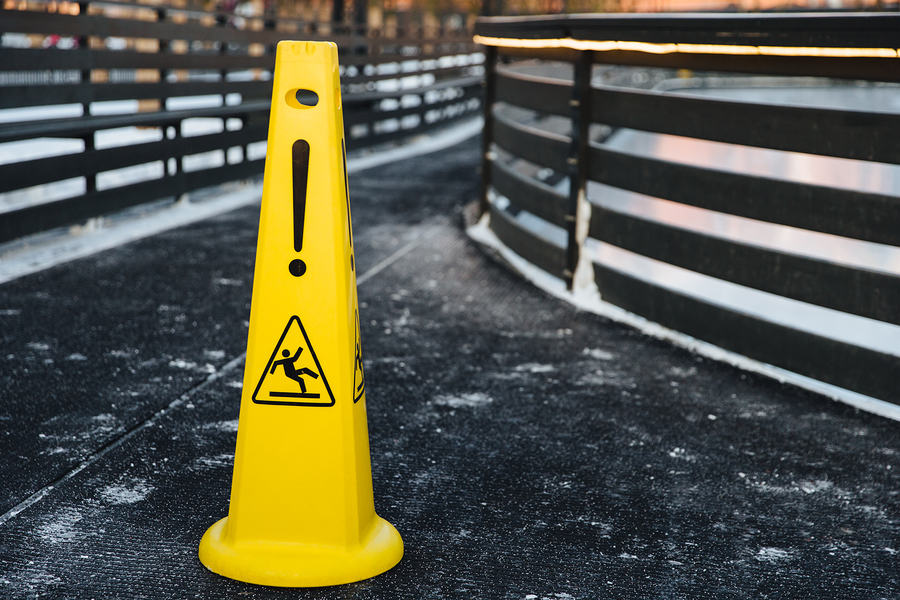
Depending upon the nature of your business, slip-and-fall injuries inside your building might be a daily threat or only an occasional hazard. While restaurants and supermarkets are particularly prone to spills, “drier” facilities pose less of a danger. Nevertheless, no organization is immune to these concerns, so it’s essential to have a reliable plan in place to protect your visitors, customers, and employees.
Assess your risks and optimize your insurance coverage
Taking into account your relative risk, your facility must be adequately insured against these mishaps. Each year, 800,000 people are hospitalized for slip-and-fall injuries—the most common being broken bones or head injuries. According to the Centers for Disease Control, the average medical cost of such an injury is $30,000. For this reason, it’s essential that you meet with an insurance professional to ensure your liability coverage is enough to protect your assets.
Along with visitors and customers, you need to be concerned about your employees. Statistics put out by the National Floor Safety Institute show that slips and falls are the leading cause of workers’ compensation claims. The Insurance Information Institute provides valuable tips for making sure your workers’ compensation coverage is adequate. You will need to consider the size and scope of your organization as well as the types of tasks workers are regularly engaged in.
Establish a specific protocol for responding to slippery conditions
For areas prone to spills, it’s essential to respond quickly, especially in high-traffic areas. A recent $1.6 million verdict in a supermarket slip-and-fall case demonstrates that failure to take immediate action can result in catastrophic consequences, both for the victim and for your organization’s bottom line.
Designate in advance which employee or employees will take action immediately if liquid spills. Make sure prominent warning signs are within easy reach to place around the wet area, as well as mops and absorbent microfiber towels, which can quickly sop up the liquid before anyone gets hurt.
Ensure that indoor mats and umbrella bags are strategically placed
In office buildings, sturdy mats should extend from the doorway to the front desk, and possibly to the elevators, to reduce the amount of snow, ice, or mud tracked in. Other facilities will have different needs. By observing foot traffic patterns in your building, you’ll be able to determine the proper placement of mats.
Wet umbrellas pose a great hazard because they are carried throughout the building. Encourage visitors to safely encase their umbrellas in a plastic bag by posting a stand at each doorway. These stands can be purchased inexpensively online or in retail stores. If wet weather is a common occurrence in your vicinity, you may even want to consider flooring alternatives to linoleum and wood, which can be particularly slippery when wet.
Get help from OSHA
The Occupational Safety and Health Administration sets and enforces safety standards in the workplace, and facility managers are well aware of the importance of complying with OSHA. A worker’s slip-and-fall injury can lead to an OSHA inspection and possible penalties. However, OSHA also offers several cooperative programs that can make it easier to remain compliant. These programs can benefit your organization in ways that inspire confidence in the community about your facility.
For example, if you can prove you’ve implemented effective safety standards and kept injury rates below the national averages kept by the Bureau of Labor Statistics, the Voluntary Protection Programs will exempt your facility from programmed inspections. You can remain exempt for as long as you remain in compliance. VPP approval is official recognition by OSHA of the outstanding efforts of employers and employees to maintain a safe workplace. This recognition demonstrates to your workers, customers, and invitees that you run a safe facility, and can do a lot to improve the goodwill value of your organization.
Consider your parking lot and walkways
You are liable for injuries that occur not only inside your premises, but also on your grounds. Make sure you have a plan in place for clearing your parking lot, whether you hire a snow plow contractor, clear the grounds yourself, or rent snow plowing equipment.
It’s also essential to make sure walkways to your doors are safe for pedestrians. Shoveling these areas takes employees away from more critical tasks, is time consuming, and can be dangerous. A quick and inexpensive solution for keeping these walkways safe is to use heated outdoor mats that provide a layer of protection between pedestrians and snowy, icy conditions.

